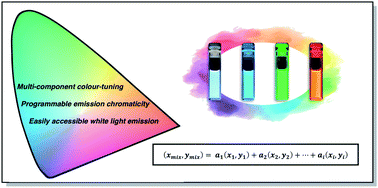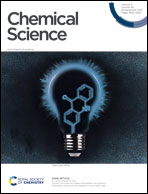Shedding light on predicting and controlling emission chromaticity in multicomponent photoluminescent systems†
Abstract
Predictable colour tuning in multicomponent photoluminescent (PL) systems is achieved using mixtures of simultaneously emitting organic molecules. By mitigating the potential for energy transfer through the control of concentration, the resulting emission chromaticity of five dichromic PL systems is approximated as a linear combination of the emitting components and their corresponding brightness (χi, ϕi, and Iex,i). Despite being limited to dilute solutions (10−6 M), colour tuning within these systems was controlled by (1) varying the composition of the components and (2) exploiting the differences in the components' excitation intensities at common wavelengths. Using this approach, white light emission (WLE) was realized using a pre-determined mixture of red, green, and blue emitting organic molecules. Based on these results, materials and devices with built-in or programmable emission colour can be achieved, including highly sought-after WLE.



 Please wait while we load your content...
Please wait while we load your content...